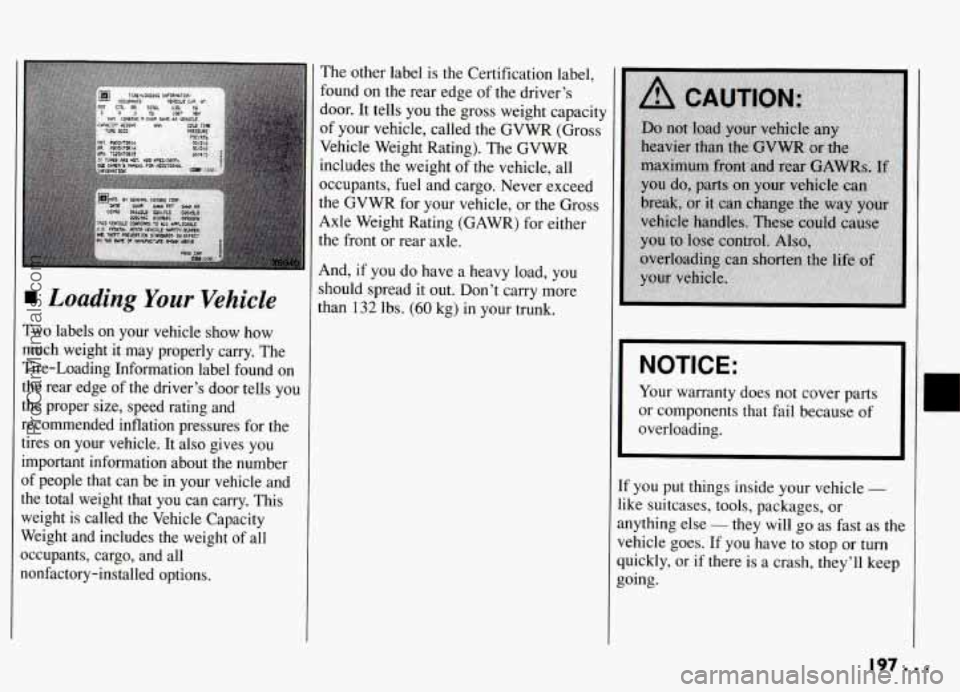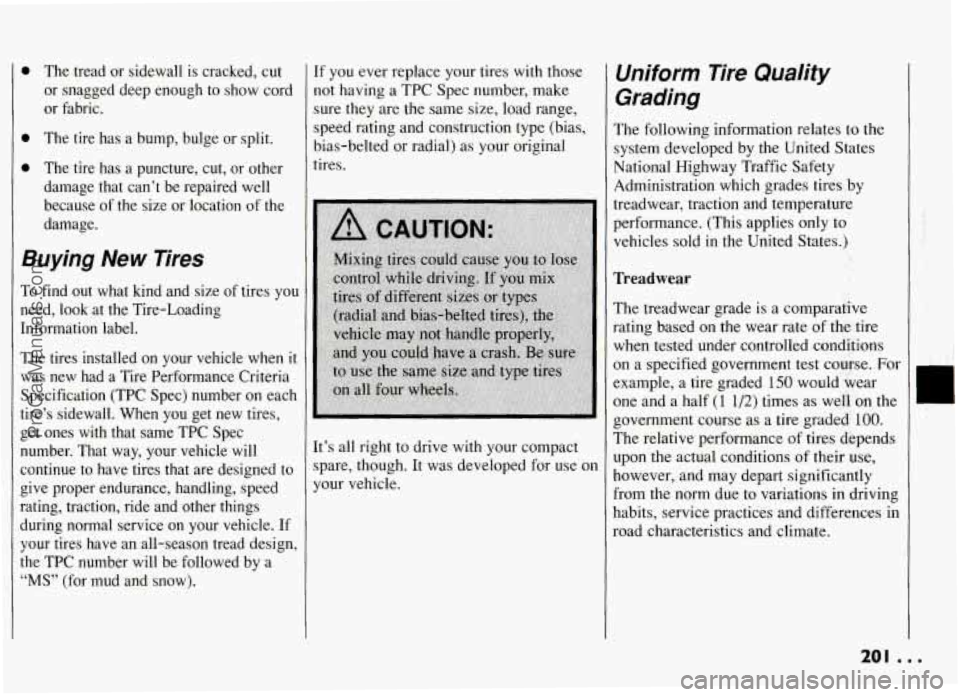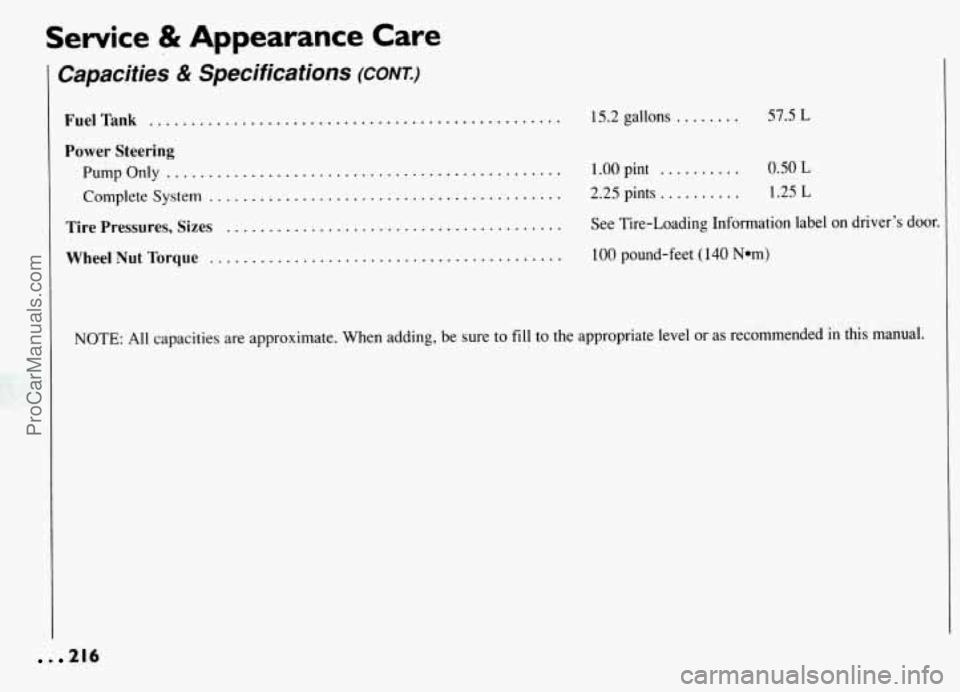1994 PONTIAC GRAND-AM tire size
[x] Cancel search: tire sizePage 168 of 274

P
t
I
A
ir:
in
Ci
SL
W
I Compact Spare Tire
hhough the compact spare was fully
lflated when your vehicle was new, it
in lose air after a time. Check the
iflation pressure regularly. It should be
3 psi (420 kPa). After installing the
Impact spare on your vehicle, you lould stop as soon as possible and make
ire your spare tire is correctly inflated.
he compact spare is made to perform
ell at posted speed limits for distances
J to 3,000 miles (5 000 km) so you can
finish your trip and have your full-size
tire repaired or replaced where you want.
Of course, it’s best to replace your spare
with a full-size tire as soon as you can.
Your spare will last longer and be
in good
shape
in case you need it again.
NOTICE:
Don’t take your compact spare
through an automatic car wash
with
guide rails. The compact spare can
get caught on the rails. That can
damage the tire and wheel, and
maybe other parts of your vehicle.
Don’t use your compact spare on some
other vehicle.
And don’t mix your compact spare or
wheel
with other wheels or tires. They
won’t fit. Keep your spare and its wheel
:ogether.
NOTICE:
Tire chains won’t fit your compact
spare. Using them will damage your
vehicle and destroy the chains too.
Don’t use tire chains on your
compact spare.
If You’re Stuck: In
Sand, Mud, Ice or
Snow
Jhat you don’t want to do when your
zhicle is stuck is to spin your wheels.
The method known as “rocking” can help
you get out when you’re stuck, but you
must use caution.
167 ...
ProCarManuals.com
Page 198 of 274

I Loading Your Vehicle
Two labels on your vehicle show how
much weight it may properly carry. The
Tire-Loading Information label found on
the rear edge of the driver’s door tells you
the proper size, speed rating and
recommended inflation pressures for the
tires on your vehicle. It also gives you
important information about the number
af people that can be in your vehicle and
the total weight that you can carry. This
weight is called the Vehicle Capacity
Weight and includes the weight of all
xcupants, cargo, and all
lonfactory-installed options.
The other label is the Certification label,
found on the rear edge of the driver’s
door. It tells you the gross weight capacity
of your vehicle, called the GVWR (Gross
Vehicle Weight Rating). The GVWR
includes the weight of the vehicle, all
occupants, fuel and cargo. Never exceed
the GVWR for your vehicle, or the Gross
Axle Weight Rating (GAWR) for either
the front or rear axle.
And, if you do have a heavy load, you
should spread it out. Don’t carry more
than
132 lbs. (60 kg) in your trunk.
I NOTICE: 1
Your warranty does not cover parts
or components that fail because of
overloading.
[f you put things inside your vehicle -
like suitcases, tools, packages, or
mything else
- they will go as fast as the
Jehicle goes. If you have to stop or turn
quickly, or if there is a crash, they’ll keep
going.
197.. .
ProCarManuals.com
Page 202 of 274

0 The tread or sidewall is cracked, cut
or snagged deep enough to show cord
or fabric.
0 The tire has a bump, bulge or split.
0 The tire has a puncture, cut, or other
damage that can’t be repaired well
because of the size or location of
the
damage.
Buying New Tires
To find out what kind and size of tires you
need, look at the Tire-Loading Information label.
The tires installed on your vehicle when it
was new had a Tire Performance Criteria
Specification (TPC Spec) number on each
tire’s sidewall. When you get new tires,
get ones with that same TPC Spec
number. That way, your vehicle will
continue to have tires
that are designed to
give proper endurance, handling, speed
rating, traction, ride and other things
during normal service on your vehicle. If
your tires have an all-season tread design,
the TPC number will be followed by a
“MS” (for mud and snow).
If you ever replace your tires with those
not having a TPC Spec number, make
sure they are the same size, load range,
speed’rating and construction type (bias,
bias-belted
or radial) as your original
tires.
It’s all right to drive with your compact
spare, though. It was developed for use on
your vehicle.
Uniform Tire Quality
Grading
The following information relates to the
system developed by
the United States
National Highway Traffic Safety
Administration which grades tires by
treadwear, traction and temperature
performance. (This applies only to
vehicles sold in the United States.)
I’readwear
The treadwear grade is a comparative
eating based on the wear rate of the tire
when tested under controlled conditions
)n a specified government test course. For
:xample, a tire graded
150 would wear
me and a half
(1 1/2) times as well on the
;overnment course as a tire graded
100.
rhe relative performance of tires depends
upon the actual conditions of their use,
however, and may depart significantly
from
the norm due to variations in driving
habits, service practices and differences in
road characteristics and climate.
ProCarManuals.com
Page 204 of 274

Your dealer will know the kind of wheel
you need.
Each new wheel should have the same
load carrying capacity, diameter, width,
offset, and be mounted the same way as
the one
it replaces.
If you need to replace any of your wheels,
wheel bolts, or wheel nuts, replace them
only
with new GM original equipment
parts. This way, you
will be sure to have
the right wheel, wheel bolts, and wheel
nuts for your Pontiac model.
NOTICE:
The wrong wheel can also cause
problems
with bearing life, brake
cooling, speedometer/odometer
calibration, headlight aim, bumper
height, vehicle ground clearance,
and tire or tire chain clearance to the
body and chassis.
Used Replacement Wheels
‘ire Chains
NOTICE:
If your Pontiac has P195/70R14,
P2 15/60VR 14, P195/65R 15 or
P205/55R16 size tires, don’t use tire
chains; they can damage your
vehicle.
If you have other tires, use tire
chains only where legal and on
when you must. Use only
SAE
Class “S” type chains that are the
proper size for your tires. Install
them on the front tires and tighten
them as tightly
as possible with the
ends securely fastened. Drive slowly and follow the chain
manufacturer’s instructions. If you
can hear the chains contacting your
vehicle, stop and retighten them. If
the contact continues, slow down
until- it stops. Driving too fast with
chains on will damage your vehicle.
lr
ProCarManuals.com
Page 217 of 274

Service & Appearance Care
Capacities & Specifications (CONT.)
Complete System . .
Tire Pressures, Sizes
Wheel
Nut Torque . .
FuelTank .................................................
Power Steering
PumpOnly ...............................................
......................................
........................................
........................................
15.2 gallons ........ 57.5 L
1.00 pint .......... 0.50 L
2.25 pints .......... 1.25 L
See Tire-Loading Information label on driver’s door.
100 pound-feet ( 140 N*m)
NOTE: All capacities are approximate. When adding, be sure to fill to the appropriate level or as recommended in this manual.
. 216
ProCarManuals.com